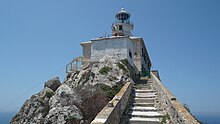Palagruža

Palagruža Lighthouse
|
|
| Location | Palagruža Island, Croatia |
|---|---|
| Coordinates | 42°23′34″N 16°15′32″E / 42.392863°N 16.258828°E |
| Year first constructed | 1875 |
| Construction | stone tower |
| Tower shape | cylindrical tower with balcony and lantern rising at the center of 2-story keeper’s house |
| Markings / pattern | unpainted tower, white lantern |
| Height | 23 metres (75 ft) |
| Focal height | 110 metres (360 ft) |
| Light source | solar power |
| Range | main: 26 nautical miles (48 km; 30 mi) reserve: 12 nautical miles (22 km; 14 mi) |
| Characteristic | Fl W 17.5s. |
| Admiralty number | E3586 |
| NGA number | 11052 |
| ARLHS number | CRO-012 |
Palagruža (pronounced [palǎɡruːʒa]; from Ancient Greek Pelagousae Πελαγούσαι from pèlagos, sea, Italian: Pelagosa) is a small, remote Croatian archipelago in the middle of the Adriatic Sea.
It consists of one larger island, called Vela or Velika ('Great') Palagruža, and a smaller one, Mala ('Little') Palagruža, as well as a dozen nearby rocks and reefs composed of dolomite. All the main islets are in the form of steep ridges.
The place is some 123 km (76 mi) south of Split, Croatia, and 53 km (33 mi) east of the Gargano peninsula, Italy. It is visible from land only from other remote islands of Italy and Croatia. Palagruža is further south than the mainland peninsula of Prevlaka, making it the southernmost point of the Republic of Croatia. It is uninhabited, except by lighthouse staff and occasional summer tourists. It can be reached only by a chartered motor-boat, requiring a journey of two to three hours from the island of Korčula.
The place is known in Italian as Pelagosa, derived from Greek pèlagos (πέλαγος, 'sea'). This is the source of the current Croatian name, as well as of the name of pelagosite. Gruž also means 'ballast' in Croatian, and the term is therefore well known in two ways to seafarers.
For some, Palagruža is associated with the Homeric hero Diomedes, king of Argos, who is reputed to be buried here, though it is hard to imagine where. Speculation is fuelled by the discovery of a painted 6th-century BC Greek potsherd with the name Diomed[es] on it (see image on Adriatica). A shrine of the cult of Diomedes here is perfectly thinkable. Authentic archaeological finds of the Neolithic, Greek, Roman, and early medieval periods have been recorded.
...
Wikipedia

